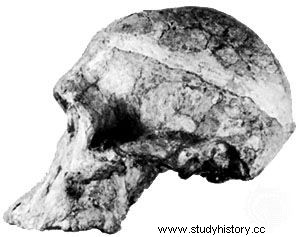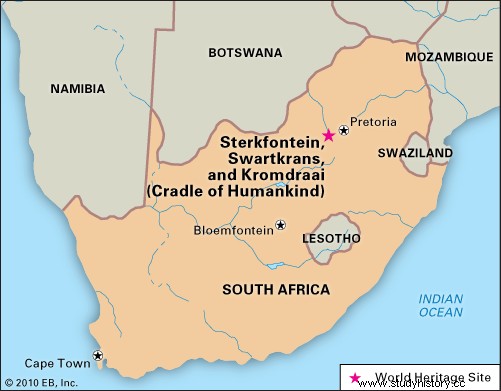Sterkfontein , site of paleoanthropological excavations south of Johannesburg , South Africa , known for its Artifacts and its fossils of ancient hominins (members of the human lineage). Located in the Highveld, the site was quarried during the 20th century for its limestone deposits. In 1936 Robert Broom from the Transvaal Museum in Pretoria began collecting fossils from the miners. This led to the first detection of an adult Australopithecus africanus , an early hominin originally from 1925 Taung , another South African site. First Broom wrote his fossils A. transvaalensis zu , of a previously unknown kind. In 1947 he discovered an adult skull so unique and well preserved that he proposed an entirely new genus, Plesianthropus transvaalensis . However, "Ms. Ples “, like that Fossil of 1947 is now associated with Broom's finds other than A. africanus classified . Crews continue to work in Sterkfontein and the website was with more than 500 fossils one of the richest sources of information about the human evolution .
The site contains six very different geological "members". Member 2 has a beautifully preserved skeleton from about 3.3 million years ago (mya). In member 4 ( approx. 2.7 mya) are the rich remains of A. africanus with its small - almost ape-sized - brain, human-like teeth and the skull in between. The body of A. africanus is fundamentally human in that it is adapted for upright walking but retains long front legs and short hind legs reminiscent of an ape recall. In member 5 (1.5 to 2 mya) there are instances that Homo habilis as well as possible remains of the "hardy" australopith. Paranthropus robustus . Stone tools are missing in Sterkfontein, which starts with A. africanus associated (members 2 and 4), conspicuous but tools abound during Member 5's time.
Sterkfontein, along with the neighboring locations of Kromdraai and Swartkrans are located in the cradle of humanity, a region declared UNESCO in 1999 Declared World Heritage Site .


